ERS Charts of Note
Subscribe to get highlights from our current and past research, Monday through Friday, or see our privacy policy.
Get the latest charts via email, or on our mobile app for  and
and 
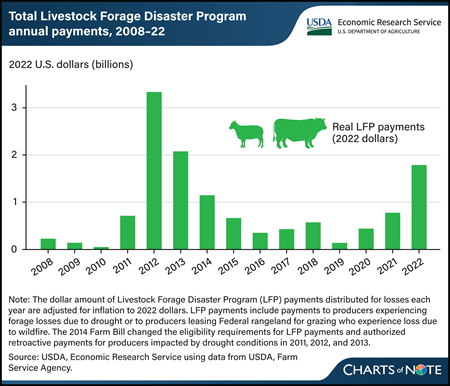
Monday, March 25, 2024
The USDA, Farm Service Agency administers the Livestock Forage Disaster Program (LFP), which provides payments to livestock producers affected by drought. From 2008 to 2022, the program distributed more than $12 billion (in 2022 dollars) in total to livestock producers throughout the United States. Annual LFP payments peaked in 2012 at more than $3 billion (in 2022 dollars) when severe, widespread drought conditions were prevalent throughout much of the central United States, where much of the Nation’s livestock production is concentrated. In general, years with widespread drought (such as in 2012, 2013, and 2022) are associated with larger total annual LFP payments. LFP eligibility is based on drought severity as reported by the U.S. Drought Monitor. If drought conditions become more severe and common in the future because of climate change, LFP payments may increase, with potential impact on the Federal Government’s budget. For more about the LFP and the potential impact of LFP payments on the Federal budget, see the USDA, Economic Research Service report The Stocking Impact and Financial-Climate Risk of the Livestock Forage Disaster Program, published in January 2024.
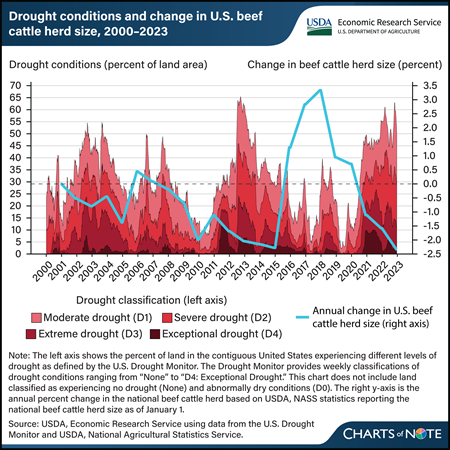
Monday, March 11, 2024
Beef cattle operations that rely on precipitation to grow forage to feed their herds are particularly vulnerable to drought. When drought conditions diminish forage production and availability, beef cattle producers often must buy supplemental feed and forage or reduce their herd size. Periods of more intense drought are associated with decreases in the U.S. beef cattle herd size, such as when the national beef cattle herd shrank about 1 to 2 percent a year during drought between 2011 and 2015. This chart also shows that cattle numbers grew in the less intense drought years of 2015 to 2018. Other factors outside of drought conditions also influence changes in the beef cattle herd size, including feed and forage prices, extreme precipitation events, supply chain issues, and the natural life cycles of livestock (i.e., the cattle cycle). To support livestock producers negatively impacted by drought conditions, the USDA administers a range of programs such as the USDA, Farm Service Agency’s Livestock Forage Disaster Program (LFP), which provides payments to livestock producers whose forage production is diminished by drought. LFP eligibility is determined by drought conditions reported by the U.S. Drought Monitor. Many livestock species, ranging from beef cattle to reindeer, are eligible for LFP payments. LFP payment rates are species specific and designed to cover about 60 percent of monthly feed and forage costs. For more about the U.S. beef cattle herd, the LFP, and the potential impact of LFP payments on the Federal budget, see the USDA, Economic Research Service report The Stocking Impact and Financial-Climate Risk of the Livestock Forage Disaster Program, published in January 2024.
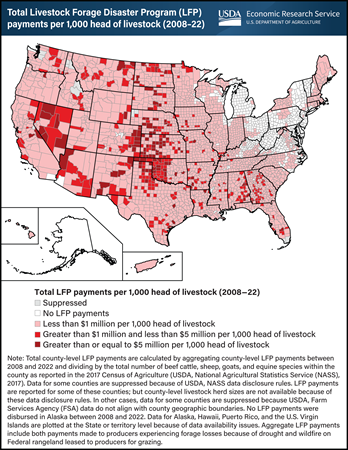
Wednesday, January 31, 2024
Drought imposes significant costs on the U.S. agricultural sector, particularly for livestock producers who rely on precipitation to grow forage. USDA’s Farm Service Agency’s (FSA) provides payments to livestock producers whose pastures and rangeland are impacted by drought through the Livestock Forage Disaster Program (LFP). The LFP was established by the 2008 Farm Bill and uses eligibility criteria based on county-level drought conditions reported by the U.S. Drought Monitor. FSA annually sets species-specific per head LFP payment rates designed to cover about 60 percent of monthly feed/forage costs for livestock. Livestock species eligible for LFP payments include traditional livestock, such as beef and dairy cattle, as well as more exotic varieties, such as reindeer and ostriches. Between 2008 and 2022, the program disbursed more than $12 billion (in 2022 dollars) of payments to livestock producers. Counties with the largest aggregate LFP payments per 1,000 head of livestock are concentrated primarily in the Western, Southern, and Central United States, where drought conditions are generally more severe and common. About 20 percent of counties in the continental United States received no LFP payments between 2008 and 2022. These counties are primarily located in urban regions and the relatively more humid Eastern United States. This chart was drawn from the USDA, Economic Research Service report The Stocking Impact and Financial-Climate Risk of the Livestock Forage Disaster Program, published January 2024.
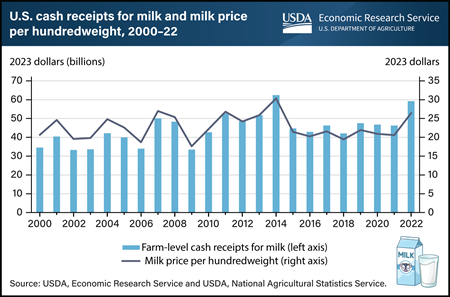
Thursday, January 11, 2024
U.S. milk production, as measured in inflation-adjusted 2023 dollars, grew $13.0 billion (or 28 percent) to $59.2 billion in 2022, the highest level since 2014, according to data from the USDA, Economic Research Service (ERS). ERS annually estimates farm sector cash receipts—the cash income received from agricultural commodity sales. This increase in receipts coincided with the U.S. all-milk price rising to $26.46 per hundredweight, a 28.6-percent gain from 2021. The all-milk price is a gross price dairy farmers receive per hundredweight of milk sold and does not include deductions for items like transportation charges, promotion costs, or co-op dues. In 2014, cash receipts for milk reached an all-time high of $62.4 billion once adjusted for inflation, about 5 percent more than the 2022 total. This chart was created using information found in the ERS Farm Income and Wealth Statistics data product updated in November 2023. Estimates of 2023 milk receipts will be released in August 2024.
Most U.S. butter and cheese is consumed domestically, while most dry skim milk products are exported
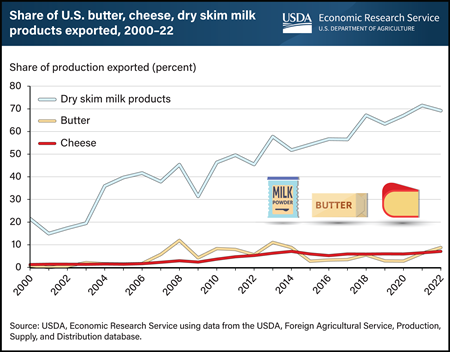
Tuesday, November 7, 2023
The United States is a large producer and exporter of dairy products. Some dairy products are exported more than others. Exports-to-production ratios, which indicate the share of total U.S. production destined for export each year, show that U.S. dry skim milk products are increasingly exported. In 2022, U.S. exports of dry skim milk products (nonfat dry milk, skim milk powder, and dry skim milk for animal use) were equivalent to 69 percent of production by volume. Since 2000, the exports-to-production ratio of dry skim milk products has increased, more than tripling from 2000 to 2022. By contrast, U.S.-produced cheese and butter mostly are kept for use in domestic markets. Though the exports-to-production ratios of butter and cheese also have trended upward, U.S. exports of butter equated to less than 9 percent of 2022 production, and exports of cheese were equivalent to about 7 percent of production. Differences between exports of butter and cheese and exports of dry milk products partly can be explained by shelf stability and ease of transport. Dry skim milk products are much easier to ship internationally and have a lower risk of spoilage than fresh and/or refrigerated dairy products. Although relatively low proportions of U.S. cheese are exported, in 2022 the United States was the second largest exporter of cheese by value worldwide, with total cheese exports estimated at nearly $2.3 billion. This chart is drawn from the USDA, Economic Research Service report U.S. Trade Performance and Position in Global Meat, Poultry, and Dairy Exports published in April 2023.
-Ice-cream_450px.png?v=1035.6)
Thursday, July 6, 2023
In 2021, U.S. residents consumed 20.3 pounds of frozen dairy products per capita, nearly 6 pounds less than in 2000. Per capita consumption of frozen dairy products, which includes ice creams and frozen yogurt among other frozen dairy products, has been declining since the 1990s, dipping to its lowest point in 2021. Consumption of regular ice cream in 2021 was estimated at 12.0 pounds per person, a drop of about 4 pounds from 2000. At 6.4 pounds, per capita consumption of low-fat and nonfat ice cream was roughly the same in 2021 as in 2000. Consumption of other dairy products, including frozen yogurt, sherbet, and miscellaneous frozen dairy products, decreased from 3.4 pounds per person in 2000 to 1.9 pounds in 2021. This downward trend in frozen dairy product consumption is in line with a decline in consumption of caloric sweeteners from 150.9 pounds per capita in 2000 to 127.4 pounds in 2021, reflecting shifting preference among consumers. This chart is drawn from Dairy Data, published by USDA, Economic Research Service (ERS), which provide annual data for per capita consumption of dairy products from 1975 to 2021. Information concerning caloric sweeteners is from ERS’ Sugar and Sweeteners Yearbook Tables. The data for this chart do not account for spoilage, waste, and other losses. For data that take these losses into account, see ERS’ Loss-Adjusted Food Availability.
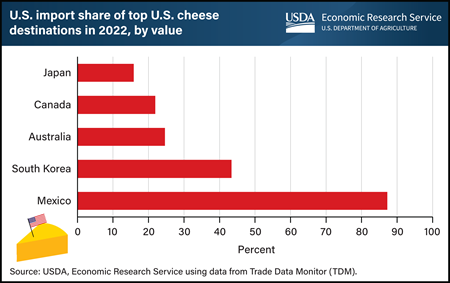
Thursday, June 8, 2023
In 2022, the United States exported more than 450,000 metric tons of cheese, valued at approximately $2.3 billion. Top export markets include Mexico, South Korea, Japan, Australia, and Canada. U.S. cheese is a mainstay among imported cheeses in these countries. In 2022, U.S. cheese accounted for nearly one-fifth of cheese imported by Canada and Japan by value and nearly one-fourth of cheese imported by Australia. More than 43 percent of cheese shipped to South Korea originated from the United States. U.S. cheese dominates the import market in Mexico, with 87 percent of Mexico’s cheese imports coming from the United States in 2022. All together, these five countries have accounted for nearly two-thirds of U.S. cheese exports since 2019, and U.S. cheese constitutes about a third of the value of all cheese imported by these five markets combined. Free trade agreements have partially supported U.S. cheese exports to each of these markets, including the U.S.-Mexico-Canada Agreement (USMCA), the U.S.-Japan Trade Agreement, the U.S.-Korea Free Trade Agreement (KORUS), and the U.S.-Australia Free Trade Agreement. This chart is drawn from the USDA, Economic Research Service report, U.S. Trade Performance and Position in Global Meat, Poultry, and Dairy Exports, April 2023.
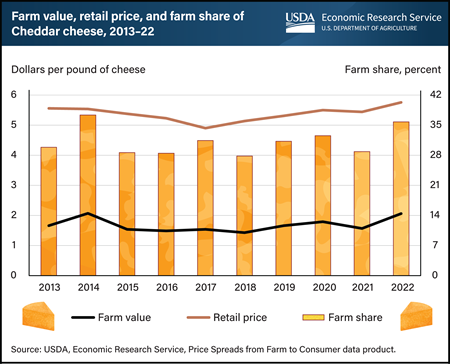
Thursday, June 1, 2023
In 2022, dairy farmers received a larger share of the retail price of Cheddar cheese than during the previous year. The ratio of what dairy farmers received for the milk used in making Cheddar cheese (farm value) compared with what consumers paid in grocery stores (retail price), called the farm share, increased to 36 percent from 29 percent in 2021. The farm value of the 10.3 pounds (1.2 gallons) of milk used to make a pound of Cheddar cheese rose 49 cents to $2.06 in 2022 from $1.57 after subtracting the value of the whey coproduct. However, the average retail cheese price increased only 32 cents to $5.76 per pound from $5.44 the previous year. U.S. dairy farmers faced high operational costs and increased their collective output by less than one tenth of one percent in 2022, leaving milk processors and cheese manufacturers to compete for limited milk supply at a higher price. Wholesale prices for Cheddar cheese rose by 21 percent when packaged in 40-pound blocks and by 31 percent for 500-pound barrels. Retailers absorbed much of these wholesale price increases instead of passing them on to consumers. This allowed domestic use of American-type cheeses (including Cheddar, Colby, Monterey, and Jack) to increase above 2021 levels. USDA, Economic Research Service (ERS) hosted a data training webinar in 2022 on farm-to-retail price spreads and farm share statistics. More information on farm share data can be found in the ERS Price Spreads from Farm to Consumer data product, updated in April 2023.
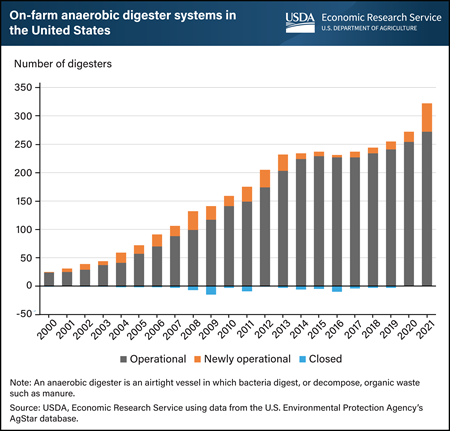
Wednesday, March 15, 2023
The number of on-farm anaerobic digester systems has steadily increased since 2000, according to AgSTAR, a collaborative program sponsored by the Environmental Protection Agency and USDA. An anaerobic digester is an airtight vessel in which bacteria digest, or decompose, organic waste such as manure, and the resulting biogas can be used to generate electricity or sold. A total of 322 on-farm systems were in operation at the end of 2021, including 50 that started operating that year. Recent growth in the number of digesters corresponds to increased demand for renewable fuel as a result of carbon credit trading and incentive programs. Further, more covered lagoons have been built as their costs have decreased. Although adoption began in the 1970s, steady growth of on-farm anaerobic digestion systems in the United States did not pick up until the 1990s. Growth then persisted until about 2013, after which it slowed considerably, then began increasing again. Many of the newer digester projects are designed to produce compressed natural gas that can be injected into pipelines to take advantage of carbon credit-trading programs such as California’s Low Carbon Fuel Standard program. Roughly 78 percent of all on-farm anaerobic digestion facilities in the United States are found on dairy farms. Digester adoption is highest in California, Wisconsin, and Pennsylvania. This chart appears in the Economic Research Service report, Increasing the Value of Animal Manure for Farmers, published March 2023.
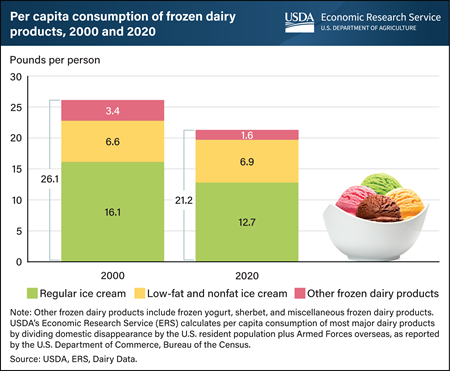
Tuesday, July 12, 2022
U.S. residents are scooping less of their favorite frozen treats than two decades ago. In 2020, the most recent year for which complete data are available, the United States consumed about 21 pounds per person of frozen dairy products—about 5 pounds per capita less than in 2000. Consumption of regular ice cream in 2020 was estimated at 12.7 pounds per person, a decrease of about 3.4 pounds (21 percent) from 2000. At 6.9 pounds, per capita consumption of low-fat and nonfat ice cream was about the same in 2020 as in 2000. Consumption of other frozen dairy products, which include frozen yogurt, sherbet, and miscellaneous frozen dairy products, decreased from 3.4 pounds to 1.6 pounds per person in the same period. This downward trend in frozen dairy products is in line with a decline in consumption of total caloric sweeteners per capita from 149.0 pounds in 2000 to 122.5 pounds per capita in 2020, reflecting shifting preferences among consumers. This chart is drawn from the USDA, Economic Research Service (ERS) data product, Dairy Data, published in September 2021. Information concerning caloric sweeteners is from ERS' Sugar and Sweeteners Yearbook Tables. The data for this chart do not account for spoilage, waste, and other losses. For data that take these losses into account, see ERS’ Loss-Adjusted Food Availability.
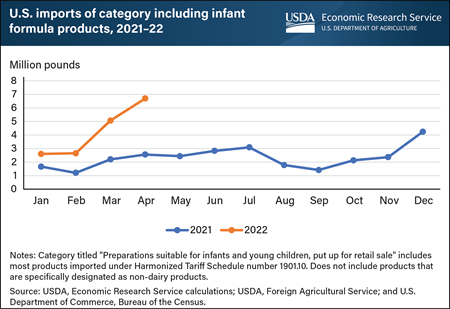
Thursday, June 16, 2022
On February 17, 2022, a major U.S. manufacturer voluntarily recalled several domestically produced varieties of powdered infant formula because of bacterial contamination concerns. The recall strained U.S. supplies of infant formula, causing reduced availability in grocery stores. The reduction of the domestic infant formula supply in retail channels has corresponded with surging imports of infant formula manufactured abroad. These imports fall under a broader category of the Harmonized Tariff Schedule of the United States for “preparations suitable for infant and young children, put up for retail sale,” which includes infant formulas. Excluding certain non-dairy products, imports of these products totaled 6.7 million pounds in April 2022. This marked a 1.6-million-pound increase from March and 4.1-million-pound year-over-year increase from April 2021. Mexico and Ireland were the leading suppliers of U.S. infant formula imports over that time. Although infant formula imports increased in March and April, domestic infant formula supplies significantly declined in May 2022, partially as a result of surging consumer demand. To further mitigate the domestic infant formula shortage, the U.S. Government unveiled actions in May 2022 to import large volumes of formula from overseas. This chart first appeared in the May 2022 Livestock, Dairy, and Poultry Outlook and has been updated with recent data.
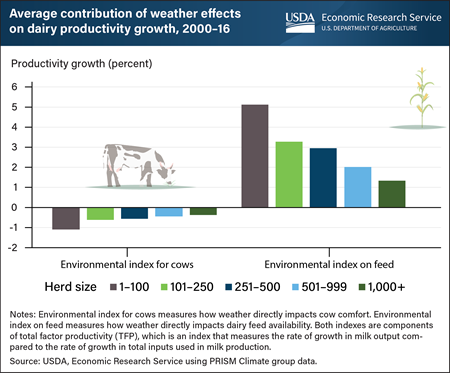
Monday, April 11, 2022
Extreme temperatures can have a negative impact on dairy cow production, as well as the growth and development of crops used for feed. New research from USDA, Economic Research Service calculates how often during a calendar year temperatures are within the optimal range for a dairy cow's maximum productivity (41–77°F), as well as the growth and development of feed crops (50–86°F), such as corn, sorghum, barley, and oats. The number of days outside these optimal temperature ranges are used to predict the effects of extreme temperature on dairy cows and feed crops. Findings indicate that all herd-size classes in several States experienced reduced growth in total factor productivity (TFP) because of extreme temperatures. TFP is an index that measures the rate of growth in milk output compared to the rate of growth in total inputs used in milk production. On the other hand, extreme weather in most States did not cause a decline in TFP by limiting feed availability. Farmers can use adaptive strategies to lessen the impacts of unfavorable temperatures on cows, which include building shade structures, installing cooling and heating systems, altering the nutrient mix, and raising heat-tolerant breeds. Similarly, farmers may resort to purchasing feed from other regions of the United States in response to adverse weather conditions that impact feed crop development in areas where dairy operations are located. This chart was drawn from the Sources, Trends, and Drivers of U.S. Dairy Productivity and Efficiency report, published in February 2022.
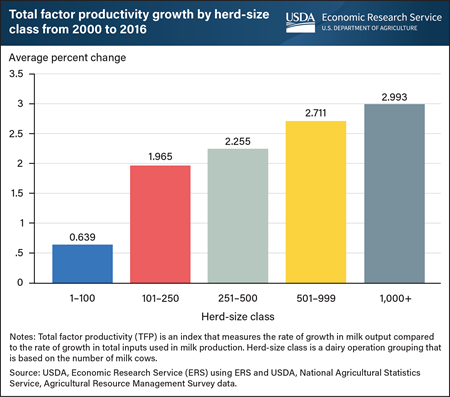
Wednesday, March 30, 2022
The U.S. dairy sector has experienced a gradual shift in milk production away from small farms toward larger dairy operations. USDA, Economic Research Service (ERS) research indicates that this shift in production from small dairy herd-size farms to large dairy herd-size farms mirrors total factor productivity (TFP) growth across the dairy sector. Total factor productivity (TFP) is a broad measure of agricultural productivity that compares the total output to the total land, labor, capital, and material inputs used in farm production. TFP measures how inputs are combined to produce output. When the total output increases faster than total inputs, TFP is said to be growing. Between 2000 and 2016, the largest dairy operations (those with more than 1,000 milk cows) experienced a TFP growth rate of 2.993 percent per year. Meanwhile, TFP growth for the smallest operations (those with fewer than 100 milk cows) increased at an annual rate of 0.639 percent. TFP growth across all operations was primarily driven by technological progress—growth associated with innovations in systems, processes, and techniques that convert inputs into milk output—and environmental effects that positively impacted feed availability. The slow growth in TFP across smaller dairy operations was primarily due to not operating the farms at a higher, optimal scale; the inability of managers to successfully combine various inputs at their disposal to maximize output; and unfavorable environmental factors that impacted the general well-being of cows. This chart was drawn from the ERS report Sources, Trends, and Drivers of U.S. Dairy Productivity and Efficiency, published February 17, 2022.
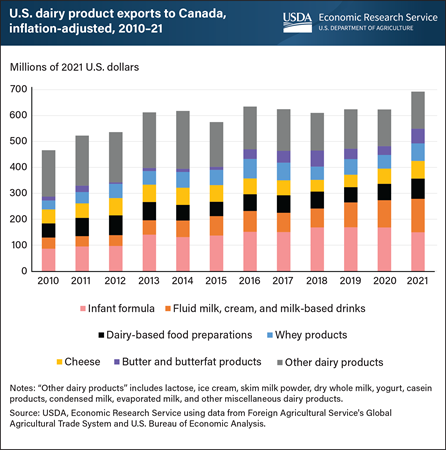
Wednesday, March 23, 2022
Canada is an important market for U.S. dairy products, second only to Mexico. From 2010 to 2021, total dairy exports from the United States to Canada, adjusted for inflation, rose 48 percent from $466.4 million in 2010 to $691.5 million in 2021. Canada’s proximity to the United States favors imports such as fluid milk, cheese, and infant formula, among others. Supplemental imports of fluid milk, butter, and butterfat in addition to cheese and cream from the United States often meet the shortfall in Canada’s production. By value, infant formula has been the top U.S. dairy product exported to Canada, accounting for $151.3 million in 2021 and representing 22 percent of the total. Coming in second, the combined export value of fluid milk, cream, and milk-based drinks reached $128.5 million in 2021—an inflation-adjusted increase of $85.2 million from 2010. U.S. exports of cheese to Canada have grown by 12 percent to $68.1 million in 2021. U.S. product groups such as butter and butterfat products; fluid milk, cream, and milk-based drinks; cheese; and whey products continue to gain popularity among Canadian buyers. Accordingly, the value of export sales of butter and butterfat products have increased by $41.7 million, after adjusting for inflation. This chart is from data in USDA, Economic Research Service (ERS) Foreign Agricultural Trade of the United States (FATUS) dataset as of February 2022. See also ERS’ Livestock, Dairy and Poultry Outlook, January 2022.
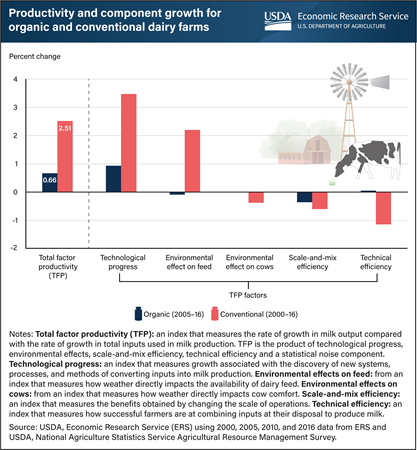
Tuesday, February 22, 2022
Organic dairy farms must follow a variety of USDA regulations to obtain certification and maintain their organic status. For example, they have to use organic grains and feed supplements, and they mostly rely on pasture-based feeding, which makes them more vulnerable to weather shocks such as drought or sudden and intense storms. These challenges mean productivity on organic dairy farms grows at a slower rate than on operations using conventional processes. Productivity is measured as total factor productivity (TFP), the ratio of the total amount of goods (in this case, milk) produced relative to all the inputs—such as labor, fertilizer, and other costs—used to produce those goods. USDA, Economic Research Service (ERS) researchers studied the difference in TFP growth between organic and conventional farms using data from organic dairy farms between 2005–16 and from conventional dairy farms between 2000–16. TFP grew at an annual rate of 0.66 percent for organic dairy farms compared with 2.51 percent among conventional dairy operations. Both organic and conventional farms saw productivity growth due to technological progress such as advanced equipment and improved genetics. While weather-related feed factors reduced productivity for organic farms, they contributed to a productivity growth for conventional dairy farms. Technical efficiency increased productivity slightly on organic farms, but reduced productivity on conventional farms, while scale-and-mix efficiency reduced productivity for both types of farms. This chart was included in the ERS report Sources, Trends, and Drivers of U.S. Dairy Productivity and Efficiency, published in February 2022.
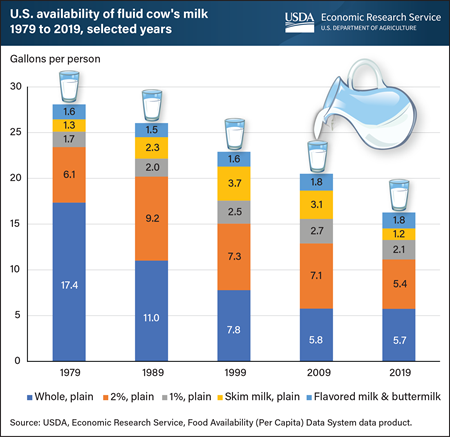
Monday, January 10, 2022
The supply of fluid cow’s milk available for U.S. consumers to drink decreased by 42 percent from 1979 to 2019, from 28.1 gallons per person to 16.3 gallons, according to USDA, Economic Research Service (ERS) food availability data. Whole milk availability drove this decline, falling nearly 67 percent to 5.7 gallons per person in 2019 from 17.4 gallons in 1979. The amount of low-fat, skim, and 1 percent milk available for U.S. consumption grew slightly over the last 40 years to a combined 3.3 gallons per person in 2019 from 3.0 gallons in 1979. Availability of 2 percent milk initially grew from 6.1 gallons per person in 1979 to a high of 9.2 gallons in 1989 before falling to 5.4 gallons in 2019. Whole milk was replaced by 2 percent milk as the most consumed milk type in 2005. Availability of flavored milk and buttermilk remained relatively steady over the last four decades, totaling 1.8 gallons per person in 2019. Several factors affect trends in U.S. per person milk availability, including competition from alternative beverages, an aging population, and changing consumer attitudes and preferences regarding milk fats. The data for this chart come from the ERS Food Availability (Per Capita) Data System.
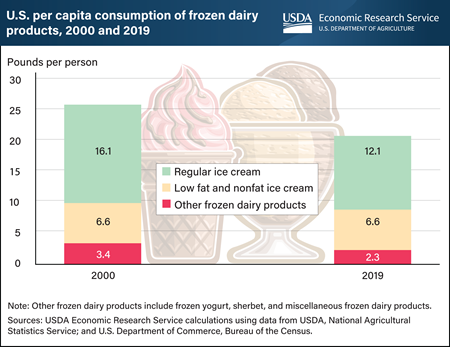
Wednesday, July 14, 2021
U.S. residents have been scooping less of their favorite frozen treats than two decades ago. In 2019, the most recent year for which complete data are available, U.S. residents consumed around 21 pounds of frozen dairy products per capita, about 4 pounds per capita less than in 2000. Consumption of regular ice cream in 2019 totaled 12.1 pounds per person, a decrease of about 4 pounds, or 25 percent, from 2000. At 6.6 pounds, per capita consumption of low fat and nonfat ice cream was about the same in 2019 as in 2000. Consumption of other frozen dairy products, which include frozen yogurt, sherbet, and miscellaneous frozen dairy products, decreased from 3.4 to 2.3 pounds per person. The downward trend in consumption of frozen dairy products corresponds with a 17 percent decline in consumption of caloric sweeteners between 2000 and 2019, reflecting increased consumer awareness about sugar intake. This chart is drawn from Dairy Data published by USDA, Economic Research Service (ERS). Information concerning caloric sweeteners is from ERS Sugar and Sweeteners Yearbook Tables.
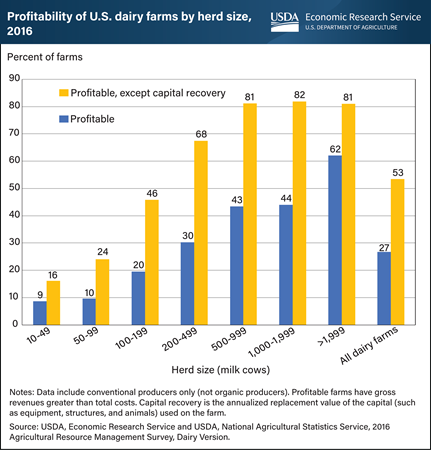
Tuesday, June 1, 2021
According to the most recently available data, in 2016, 62 percent of U.S. dairy farms with at least 2,000 cows generated gross returns that exceeded total costs, compared with 43 to 44 percent of farms in the two next-largest classes (500-999 cows and 1,000-1,999 cows). In the smallest classes (10-49 cows and 50-99 cows), less than 10 percent of farms generated positive net returns. Total costs include cash expenses such as those for feed, fuel, and hired labor, but they also include estimates of the costs of the farm’s capital and of the family labor provided to operate the dairy farm. A farm that does not cover total costs can continue to operate, and to provide a living for the family operating the farm, if it covers cash expenses and the costs of the family’s labor (total cost except capital recovery). For example, while about 20 percent of farms with 100-199 cows earned positive net returns in 2016, 46 percent earned enough to cover all cash expenses and to provide a living for the farm family. However, these farms did not earn enough to cover annual costs of capital recovery (the replacement value of the capital, such as equipment and structures, used on the farm). Continued operation makes financial sense for those farms until the cash expenses of maintaining an aging plant rise enough to cut into the family’s income from dairy farming. This chart appears in the Economic Research Service report Consolidation in U.S. Dairy Farming, released July 2020. It also appears in the August 2020 Amber Waves feature, Scale Economies Provide Advantages to Large Dairy Farms.
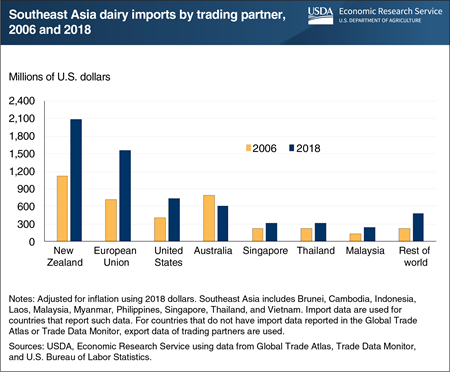
Monday, January 11, 2021
Dairy consumption is on the rise in Southeast Asia, a region characterized by rapid economic growth, urbanization, and changing food consumption patterns. To meet rising demand, many dairy products must be imported because the region’s climate limits its ability to produce milk. The value of imported dairy products in Southeast Asia grew from $3.8 billion in 2006 (adjusted for inflation) to $6.3 billion in 2018. Dairy products imported from the United States grew from $401 million to $738 million over that time, and dairy imports from most other trading partners rose as well. Imports from Australia, however, declined after years of drought resulted in lower milk yields and smaller dairy herds, and the United States overtook Australia in rank, rising from the fourth to the third largest dairy import supplier for the region. Southeast Asian countries also import dairy products from their regional neighbors and the rest of the world. The top dairy products imported by Southeast Asian nations are skim milk powder, whole milk powder, infant formula, butterfat products, cheese, and whey products. The United States is a major supplier of skim milk powder, whey products, cheese, and lactose to the region. This chart was drawn from the Economic Research Service report, Prospects for Growth in U.S. Dairy Exports to Southeast Asia.
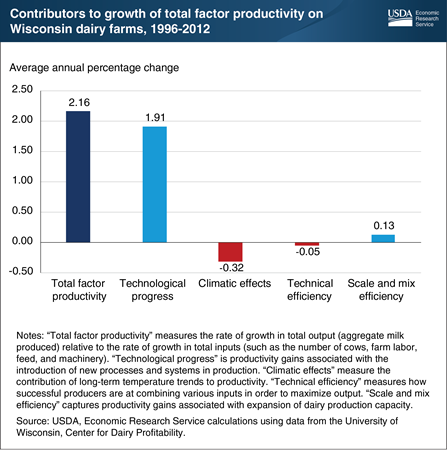
Monday, November 16, 2020
In 2019, Wisconsin’s production of fluid milk was second only to California’s. According to data from USDA’s National Agricultural Statistics Service, Wisconsin generated 30.6 billion pounds of milk that year, with milk sales totaling $5 billion. In recent years, Wisconsin dairy farms have been exposed to substantial weather volatility characterized by frequent droughts, storms, and temperature extremes (both hot and cold). This has resulted in considerable fluctuations in dairy productivity. Researchers from the Economic Research Service (ERS) among others, found that total factor productivity (TFP), which measures the rate of growth in total output (aggregate milk produced) relative to the rate of growth in total inputs (such as the number of cows, farm labor, feed, and machinery), increased at an average annual rate of 2.16 percent for Wisconsin dairy farms between 1996 and 2012. This increase was primarily driven, at an annual rate of 1.91 percent, by technological progress—such as improved herd genetics, advanced feed formulations, and improvements in milking and feed handling equipment. However, trends in rainfall and temperature variation were responsible for a 0.32 percent annual decline in the productivity of Wisconsin dairy farms during the same period. For example, an average increase in temperature of 1.5 degrees Fahrenheit reduced milk output for the average Wisconsin dairy farm by 20.1 metric tons per year. This is equivalent to reducing the herd size of the average farm by 1.6 cows every year. This chart appears in ERS’s October 2020 Amber Waves finding, “Climatic Trends Dampened Recent Productivity Growth on Wisconsin Dairy Farms.”


